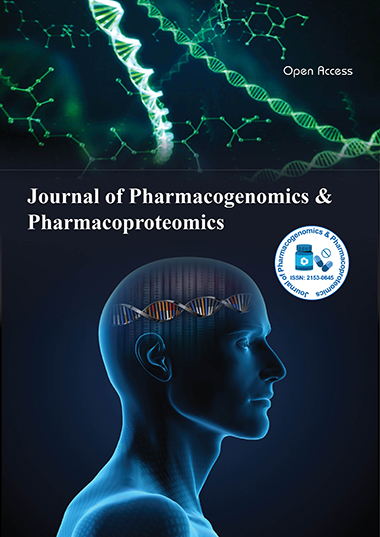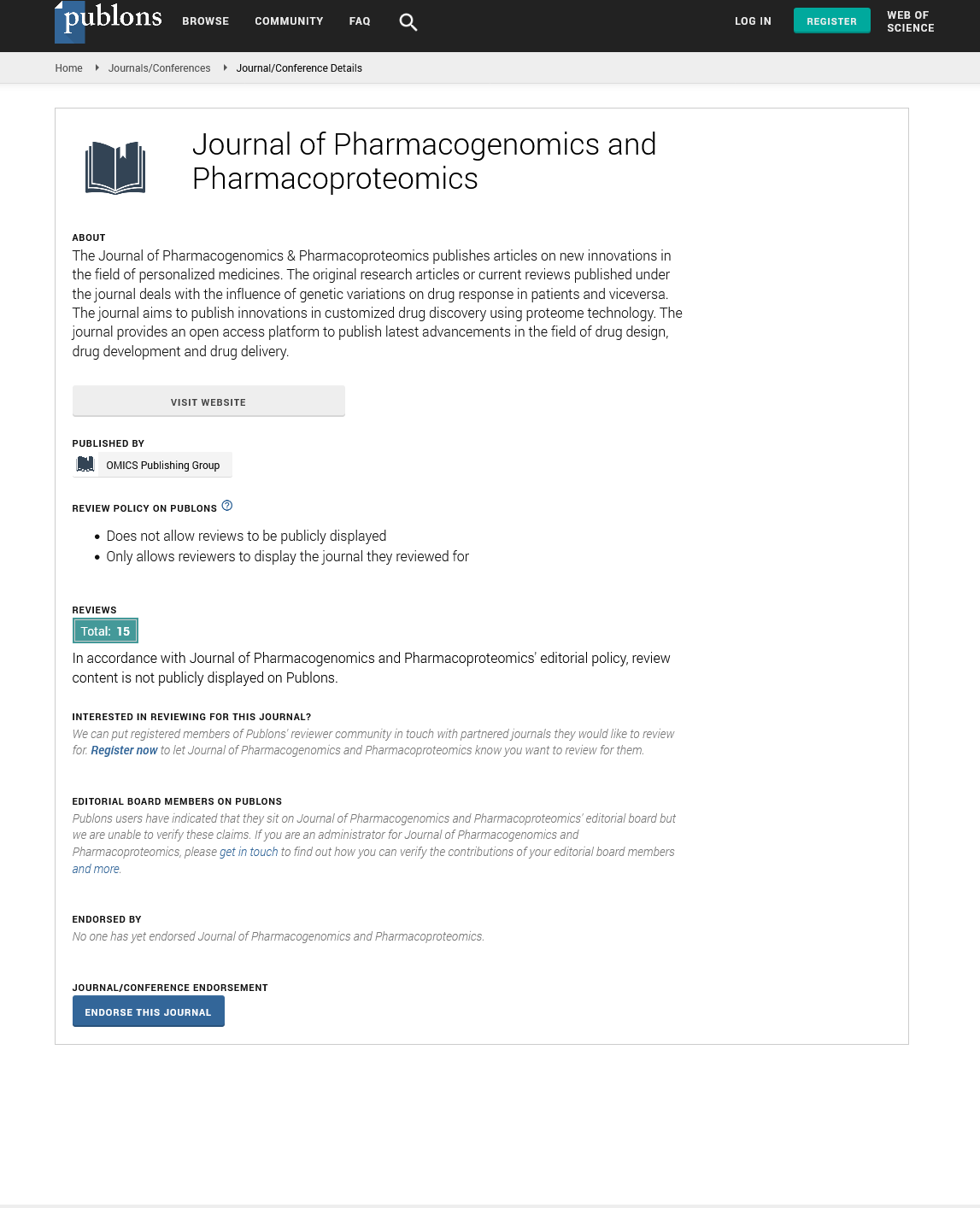Indexed In
- Open J Gate
- Genamics JournalSeek
- Academic Keys
- JournalTOCs
- ResearchBible
- Electronic Journals Library
- RefSeek
- Hamdard University
- EBSCO A-Z
- OCLC- WorldCat
- Proquest Summons
- SWB online catalog
- Virtual Library of Biology (vifabio)
- Publons
- MIAR
- Euro Pub
- Google Scholar
Useful Links
Share This Page
Journal Flyer

Open Access Journals
- Agri and Aquaculture
- Biochemistry
- Bioinformatics & Systems Biology
- Business & Management
- Chemistry
- Clinical Sciences
- Engineering
- Food & Nutrition
- General Science
- Genetics & Molecular Biology
- Immunology & Microbiology
- Medical Sciences
- Neuroscience & Psychology
- Nursing & Health Care
- Pharmaceutical Sciences
Opinion Article - (2025) Volume 16, Issue 1
SLCO1B1 Polymorphisms and Statin-Induced Myopathy: A Clinical Pharmacogenomic Perspective
Ricardo Mendez*Received: 26-Feb-2025, Manuscript No. JPP-25-29329; Editor assigned: 28-Feb-2025, Pre QC No. JPP-25-29329(PQ); Reviewed: 14-Mar-2025, QC No. JPP-25-29329; Revised: 21-Mar-2025, Manuscript No. JPP-25-29329(R); Published: 28-Mar-2025, DOI: 10.4172/2153-0645.25.16.127
Description
Statins are the most widely prescribed class of lipid-lowering medications for the primary and secondary prevention of cardiovascular disease. While generally well-tolerated, a subset of patient’s experience Statin-Associated Muscle Symptoms (SAMS), ranging from mild myalgia to severe rhabdomyolysis. This variability in drug response and toxicity has prompted investigations into genetic factors influencing statin pharmacokinetics. Among these, polymorphisms in the SLCO1B1 gene, which encodes the hepatic transporter OATP1B1, have emerged as key determinants of statin disposition and toxicity.
Multiple pharmacogenomics studies have substantiated the link between the SLCO1B1*5 polymorphism and statin-induced adverse effects. The SEARCH trial, one of the largest pharmacogenetic investigations in cardiovascular pharmacotherapy, demonstrated that individuals homozygous for the C allele had a 16-fold increased risk of simvastatin- induced myopathy compared to non-carriers. This finding has been replicated in various ethnic populations, including European, Asian, and African cohorts, although allele frequencies and effect sizes vary.
In Portuguese patients, recent data from the Gen Cardio study indicated a 14.3% frequency of the *5 allele, with a higher prevalence in statin-intolerant individuals. Furthermore, patients with the TC or CC genotype reported higher rates of muscle pain and discontinuation of therapy. This has direct clinical implications, as adherence to statin therapy is critical for long- term cardiovascular risk reduction, and early identification of at- risk individuals could prevent avoidable morbidity.
In response to accumulating evidence, the Clinical Pharmacogenetics Implementation Consortium (CPIC) has published guidelines recommending SLCO1B1 genotyping for patients prior to initiating simvastatin, particularly at high doses. For patients with decreased or poor function alleles, lower doses or alternative statins such as pravastatin or rosuvastatin are advised due to their reduced dependence on OATP1B1-mediated transport.
Despite the clarity of the genotype-phenotype relationship, clinical implementation of SLCO1B1 testing remains limited. Barriers include lack of reimbursement policies, clinician unfamiliarity with genetic results, and the perception that alternative statins can be trialed without the need for genetic confirmation. Nonetheless, institutions such as the University of Porto Medical Center have begun integrating preemptive SLCO1B1 testing into their cardiovascular clinics, with early reports showing a decrease in statin discontinuation rates and improved patient satisfaction.
Emerging research is also exploring the broader implications of SLCO1B1 polymorphisms beyond statins. The transporter is involved in the hepatic uptake of various other drugs, including certain antidiabetics, antivirals, and chemotherapeutics. Thus, SLCO1B1 genotyping could evolve into a multipurpose pharmacogenomics marker, especially in patients receiving polypharmacy.
Pharmacoproteomic analyses are further enhancing our understanding of OATP1B1 expression and function. Mass spectrometry-based assays are now capable of quantifying transporter abundance in liver biopsy samples, revealing inter- individual variability that sometimes exceeds that predicted by genotype alone. These findings suggest that integrating proteomic data with genotyping could refine risk stratification for SAMS and guide more nuanced clinical decisions.
It is also important to consider the pharmacoeconomic implications of implementing SLCO1B1 testing. Simulation models suggest that genotyping, when applied selectively to patients starting high-dose simvastatin or with prior intolerance, is cost-effective and may reduce long-term healthcare expenditures by avoiding hospitalizations due to rhabdomyolysis or emergency visits for muscle-related complaints.
In summary, SLCO1B1 polymorphisms, particularly the *5 variant, play a pivotal role in determining individual susceptibility to statin-induced myopathy. Incorporating SLCO1B1 genotyping into clinical practice offers a tangible opportunity to improve the safety and tolerability of statin therapy, thereby enhancing adherence and clinical outcomes. As the field of pharmacogenomics matures, transporter polymorphisms such as SLCO1B1 should be considered essential components of personalized cardiovascular medicine.
Citation: Mendez R (2025) I SLCO1B1 Polymorphisms and Statin-Induced Myopathy: A Clinical Pharmacogenomic Perspective. J Pharmacogenom Pharmacoproteomics.16:127.
Copyright: ©2025 Mendez R. This is an open-access article distributed under the terms of the Creative Commons Attribution License, which permits unrestricted use, distribution and reproduction in any medium, provided the original author and source are credited.

